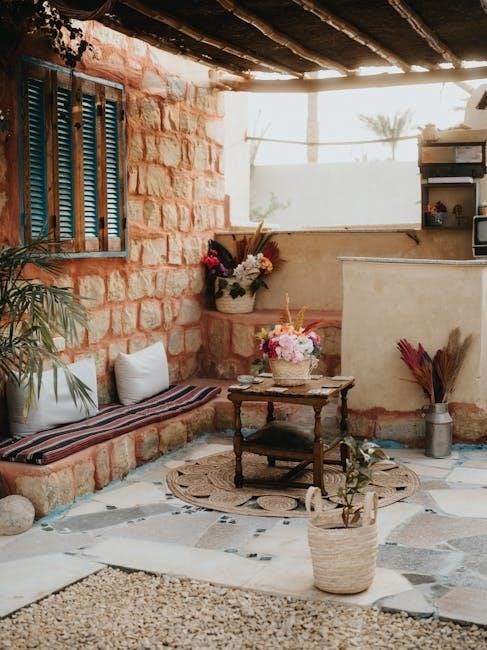Welcome to our guide on patio cover plans! Discover comprehensive designs, materials, and construction steps to create the perfect shaded outdoor space for relaxation and entertainment.
What Are Patio Cover Plans?
Patio cover plans are detailed blueprints or instructions designed to guide the construction of patio covers. These plans are created by architects, designers, and construction experts to ensure durability and aesthetic appeal. They typically include measurements, materials, and step-by-step building techniques. Patio covers are one-story structures, usually attached to a house, open on at least two sides, and no taller than 12 feet. These plans cater to both DIY enthusiasts and professionals, offering customizable designs to suit various styles and preferences. Available in PDF format, they provide a clear roadmap for creating a shaded outdoor space, whether for relaxation or entertainment.

Design Factors to Consider
When designing a patio cover, consider roof load, materials, size, style, and local building codes to ensure durability and structural integrity for your outdoor space.
Roof Design and Load
Road Design and Load are critical for ensuring structural integrity. The roof must support both dead loads (e.g., framing materials) and live loads (e.g., snow or rain). According to the International Building Code and local regulations, the design load is the sum of these weights. A lean-to roof with a 2:12 pitch is ideal for shedding water and snow, while a gabled roof offers a traditional aesthetic. Proper planning ensures safety and longevity, preventing collapse or damage. Always consult local building codes to determine the required load-bearing capacity for your area.
Materials and Durability
Materials and durability play a significant role in the longevity of your patio cover. Wood, such as cedar or pressure-treated pine, is a popular choice for its aesthetic appeal and durability. Cedar, when properly sealed, can last up to 30 years, while pressure-treated pine may last 10-15 years if maintained. Metal and fabric covers offer modern alternatives, with metal providing long-lasting strength and fabric offering portability and style. Each material has its benefits and drawbacks, so selecting the right one depends on your budget, climate, and desired appearance. Proper maintenance, like staining and sealing, ensures your patio cover withstands the elements and remains functional for years.
Size and Style
Size and style are crucial elements in patio cover design. The size should complement your outdoor space, ensuring functionality while maintaining aesthetic balance. Popular sizes include 12×16 and 10×12 feet, offering ample coverage for gatherings. Styles range from modern lean-to designs with angled roofs to traditional gabled or flat roofs. Wooden covers often feature classic looks, while metal and fabric options provide contemporary flair. The pitch of the roof, such as 2:12 or 1.5:12, affects both drainage and visual appeal. Additionally, decorative elements like hardware and trim can enhance the overall design. Choosing the right size and style ensures your patio cover blends seamlessly with your home and meets your lifestyle needs. Proper planning guarantees a functional and visually appealing structure.
Types of Patio Covers
Patio covers come in various styles, including attached, free-standing, and wooden designs; Metal and fabric options offer durability and modern aesthetics, while traditional wood provides timeless charm and strength.
Attached vs. Free-Standing
Attached patio covers are connected to your house, offering shade and protection while enhancing outdoor living spaces. Free-standing covers, however, can be placed anywhere in your yard. Attached designs often require proper integration with your home’s structure, ensuring stability and seamless aesthetics. Free-standing options provide flexibility, allowing you to create shaded areas away from your house. Both types are available in various materials, such as wood or metal, and can be customized to match your home’s style. When choosing between them, consider factors like space, budget, and desired functionality. PDF plans for both styles are widely available, offering detailed instructions for DIY projects or professional installations.
Wooden Patio Covers

Wooden patio covers are a popular choice for their natural beauty and durability. Made from materials like cedar, pine, or redwood, these structures blend seamlessly with outdoor environments. They offer excellent protection from the sun and rain while adding a rustic charm to your backyard. Properly sealed and stained, wooden patio covers can last for 20 to 30 years, though they require regular maintenance to prevent rot and warping. Designs range from simple lean-to styles to intricate pergolas, allowing for customization to match your home’s aesthetic. Free PDF plans are available online, providing detailed instructions for building wooden patio covers as a DIY project.
Metal and Fabric Patio Covers
Metal and fabric patio covers offer modern and versatile solutions for outdoor shading. Metal covers are durable, low-maintenance, and fire-resistant, making them ideal for long-lasting protection. They come in sleek designs and can withstand heavy loads like snow. Fabric covers, on the other hand, provide a stylish and flexible option, available in various colors and patterns. They are often less expensive and easier to install than metal or wood. However, fabric covers may require more frequent maintenance due to weather exposure. Both options can be customized to fit your patio’s size and style, with free PDF plans available for DIY enthusiasts to explore these designs.

Free Patio Cover Plans PDF
Download free patio cover plans PDF for DIY projects, including detailed blueprints for wooden, metal, and fabric designs. Perfect for creating shade with ease and style.
Popular Free Plans
Explore a variety of popular free patio cover plans designed for DIY enthusiasts. These plans include detailed blueprints for 12×16 attached patio covers, 16×20 lean-to designs, and 14×14 sloped patio covers. Many feature a 2:12 or 1.5:12 roof pitch, suitable for both shade and weather protection. Downloadable PDFs often include foundation plans, roof details, and material lists. Whether you prefer wooden structures with hidden connectors or metal designs, these plans cater to diverse styles and budgets. Perfect for homeowners seeking to enhance their outdoor spaces, these free resources provide step-by-step guidance for a professional finish. Start your project today with these easy-to-follow layouts.

DIY Projects
Engage in exciting DIY projects with our selection of patio cover plans. These projects are designed for homeowners of all skill levels, offering step-by-step instructions for constructing wooden patio covers, lean-to roofs, and pergolas. Many plans include detailed PDF blueprints, material lists, and tool requirements. Choose from modern designs like the 1420 Lean-to Pavilion or the 16×20 attached patio cover. With these guides, you can create a durable and stylish outdoor space tailored to your needs. Whether you’re aiming for a simple shade structure or an elaborate entertaining area, these DIY projects ensure a professional result with minimal cost and effort. Start building your dream patio today!

Construction Steps
Follow structured construction steps to build your patio cover, from planning and preparation to framing, roofing, and finishing touches, ensuring a sturdy and aesthetically pleasing outdoor space.
Planning and Preparation
Planning and preparation are crucial for a successful patio cover project. Start by assessing your site, ensuring it’s level and clear of obstacles. Check local building codes and regulations to ensure compliance. Determine the size and style of your patio cover based on your needs and available space. Create detailed blueprints or use pre-made patio cover plans PDF to guide your project. Obtain all necessary permits before beginning construction. Gather tools and materials, ensuring everything is measured and cut accurately. Proper planning will help avoid costly mistakes and ensure a smooth building process. Take your time to prepare thoroughly for the best results.

Building the Frame
Constructing the frame is the foundation of your patio cover. Begin by setting the footings according to your patio cover plans PDF. Use durable materials like wood or metal, ensuring they are weather-treated. Assemble the posts and beams, securing them firmly to the ground and each other for stability. Attach the frame to your house if building an attached patio cover, ensuring a secure connection. Double-check all measurements and alignments for accuracy. Use brackets and connectors for added strength, especially in areas with heavy snow or wind. A sturdy frame ensures safety and longevity, so take your time to build it right.
Installing Roofing
Installing roofing is a critical step in your patio cover project. Begin by ensuring the frame is secure and level. Choose your roofing material—such as metal, asphalt shingles, or corrugated metal—and follow the manufacturer’s instructions. Lay the roofing material evenly, starting from the lowest point to ensure proper drainage. Secure each panel or shingle with screws or nails, spacing them as recommended. Seal any gaps or overlaps to prevent water leakage. For fabric roofs, stretch the material tightly and attach it to the frame using the provided hardware; Finally, inspect the roof for stability and weatherproofing. Proper installation ensures durability and protection from the elements.
Finishing Touches
After constructing the frame and installing the roof, the final step is adding finishing touches. Install decorative trim or molding to cover any exposed edges or gaps. Sand and paint or stain the wood to match your home’s exterior. Add lighting fixtures or ceiling fans for ambiance and functionality. Ensure all hardware is securely tightened and weatherproofed. Consider adding decorative elements like fretwork or lattice for a personalized look. Finally, inspect the entire structure for any imperfections and make necessary adjustments. These finishing touches will enhance the appearance and functionality of your patio cover, creating a inviting outdoor space for years to come.
With the right patio cover plan, you can transform your outdoor space into a functional and stylish retreat. Whether you choose a wooden, metal, or fabric design, these structures offer shade and protection. By following detailed PDF guides, you can ensure a sturdy and visually appealing result. Proper planning, material selection, and construction techniques are key to longevity. Don’t hesitate to explore free patio cover plans and DIY projects to find the perfect fit for your home. Start your project today and enjoy countless moments under your new patio cover, enhancing your outdoor living experience for years to come.
